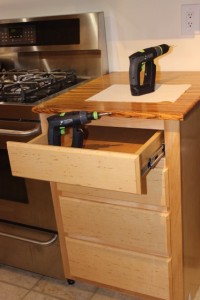We may receive a commission when you use our affiliate links. However, this does not impact our recommendations.
My shop is large by some standards, small by some, and about average to a lot of woodworkers. It doesn’t matter, it’s all relative. No matter how large your shop, there are always projects that will not fit without careful planning and staging.
A perfect case in point is a new section of kitchen base cabinet I built to reside alongside a new stove. It is a fairly large piece with four deep drawers and a butcher-block wood top. If it were not for the other three projects also underway at the same time, I probably could have built and finished the cabinet wholly within the confines of my shop. But at the time, there simply was not enough space.
Instead, I employed a tactic called “partial in-situ construction.” “In-situ” means “on site” or “in position” therefore, as the name implies, partial in-situ refers to construction that is partly done in the workshop and partly done on site.
In the case of the kitchen cabinet, I built the drawers first. Those were finished and stacked in place in the kitchen, out of the shop and out of my way. Next I built the face frame and fabricated the drawer fronts because finish could be applied with the parts standing upright, therefore taking little space. It was also important to assure the finish matched perfectly between drawer fronts and face frames. Next came the butcher-block top. It takes a lot of bench space to glue up a top, and an equal amount of space to prep the surface and apply the finish.
With all the finished sub-components safely tucked away inside the house, I had plenty of room to build the cabinet case. When the cabinet box was finished, final assembly inside the house was quick and easy. Attach the face frame, mount the drawer slides, install the drawers, attach the drawer faces, and install the top.
There is another advantage to partial in-situ construction. Each of the sub-components could be carried into the house easily. The completely assembled cabinet would have been entirely too heavy to carry in without assistance.
By its nature, partial in-situ construction can be, and is often done, in a non-linear fashion. Today’s self-close-soft-close drawer slides are a miracle in engineering, but the tolerances between drawer sides and face frames or cabinet sides is tight… the drawer width essentially must be perfect for the slides to function well. By building the drawers before the face frames, I could have made tiny adjustments to the face frame dimensions if necessary to make sure the drawers fit perfectly… it is a lot harder to adjust the size of a finished drawer.
Partial in-situ construction is just one of many strategies explored in “Super Small Shop Strategies,” an essential class for anyone who has ever felt their shop was too small.
If you never seem to have enough room in your workshop, take Steve’s Popular Woodworking University class, Super Small Shop Strategies. You’ll learn how to make the most of a small or crowded space.
Here are some supplies and tools we find essential in our everyday work around the shop. We may receive a commission from sales referred by our links; however, we have carefully selected these products for their usefulness and quality.









